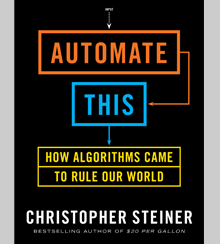Paging Dr. Bot
Joe Flower, author of Healthcare beyond Reform: Doing It Right for Half the Cost, introduces a passage describing how automation can improve healthcare outcomes and reduce costs from Automate This: How Algorithms Came to Rule Our World, by Christopher Steiner.
Medicine has always been a cottage industry, a massive series of one-off health interventions in which every step is filled with human handling and judgment. But it cannot go on this way. Everywhere around the world, from sub-Saharan Africa to the United States, healthcare systems are bumping up against the functional limits of traditional medical ways and means.
There are certainly elements of healthcare for which no machine can substitute: the empathetic, experienced observation of a good clinician and the grace of human contact and care for those suffering and dying. But as Christopher Steiner explains in the excerpt below, many of the everyday operations of healthcare, for example, scanning slides of cells for signs of abnormalities, can be easily quantified and standardized — and thus managed more effectively by algorithms run on machines.
Efficiency used to be a worthy ideal in healthcare settings. But now it is a necessity — and one that requires not only incremental improvements, but step-wise transformations. We won’t be able to provide quality healthcare to everyone without it.
— Joe Flower
An excerpt from Chapter 6 of Automate This: How Algorithms Came to Rule Our World
Health care is full of easy wins for algorithms. The first thing to change will be how we analyze test results. The frequency, complexity, and costs of tests, from Pap smears to X-rays to MRIs to CT scans, have been among the major contributors to the explosion of health care costs during the last twenty years. When somebody shows up at the doctor not feeling well, they’re often subjected to a gauntlet of tests no matter what their symptoms indicate about their condition. When that flurry of tests is over, another one often follows. Even when there’s a 99.9 percent likelihood the test isn’t needed, it’s usually still mandated. The result, for those doing the testing, is an avalanche of easy revenue — thus exemplifying how capitalism, although it’s an effective paradigm for most of the economy, is not an efficient way to administer health care. A multitude of stats can be called on to support this, but simply consider that the United States’ average life expectancy of seventy-eight years is the same as that of Cuba, a country that spends less than 10 percent per capita of what the United States does on health care but achieves roughly the same result.
But this isn’t about an ideological battle. It is about algorithms bettering the system we have in the United States — and they will do that initially by becoming the default scanners, observers, and analysts of all of these tests. Where once your results required the expensive attention of a radiologist or a pathologist, in the future the attention of an algorithm will do just fine. It will, in fact, do better.
Take the Pap test, originally called the Pap smear (named after its Greek inventor, Georgios Papanikolaou). The test has cut down on cervical cancer mortality rates in the United States by more than 90 percent since it was first introduced in the 1940s. It examines a slide of a small sample of cells drawn from a woman’s cervix. The slide first goes to a cytotechnologist, a person specially trained to do one thing: look for signs of abnormalities in the cells that may indicate cancer. Suspect slides are then passed to a pathologist, an MD who may earn more than $300,000 per year. There exist algorithms that can already replace the cytotechnologist. Even better (or worse, if you’re a cytotechnologist), the algorithms help find more instances of cancer than their human competitors by scanning each image for visual clues that mimic those known to reveal cancers in old cataloged images. In one study carried out by BD, a medical technology company that creates some of the equipment behind the testing, labs using their algorithm in tandem with a cytotechnologist spotted 86 percent of cancer instances versus 79 percent for those scanning without the algorithm. The rising use of algorithms in medical scanning will snare more problems, like cancer, earlier, and minimize false negatives, the scariest issue with such scans. Even incremental improvement would change thousands of lives; in the United States alone, more than fifty-five million Pap tests are carried out every year…
The first step in slowing out-of-control testing costs in U.S. health care was to ship some test analyses to well-trained doctors in India. The next — and final — answer will be turning all of this work over to algorithms that, when perfected, will do a better job than humans in India, America, or anywhere else. The jobs for people reading scans, tests, and patient metadata are certainly endangered. Just as threatened as this workforce are the people who measure and dole out our medications. Pharmacists in urban areas can make more than $130,000 a year. Their job is stressful, detail-oriented, and can be, unfortunately for pharmacists, easily quantified. That means the profession begs for a bot invasion, and it’s imminent. In 2011, the University of California at San Francisco opened a pharmacy staffed by nobody except a single robot. A Swiss logistics firm, Swisslog, created the $15 million robot for UCSF.
The machine, which receives information straight from the electronic messages that already go between doctor’s offices and pharmacies, has long, dexterous arms that pluck and pack pills from thousands of bulk boxes that are built into the walls of the contraption. The bot receives all information regarding the patient, including their condition, any allergies, and all other medications they may be on. Algorithms within the bot quickly check for conflicts and complications with the new prescription, ensuring that there will be no detrimental drug interactions. The algorithms in the UCSF machine don’t need any time to read up on the latest in pharmacology; they get updated drug information through electronic messages from pharmaceutical companies and assimilate it immediately. The machine, unlike a human, forgets nothing. That’s not to say that a machine can’t make an error — bugs can affect the best-written programs. But bugs are also easily fixed and algorithms can run concurrent tests on the bot that doles out the drugs, building safety redundancy into the robot pharmacist.
The bot in San Francisco has now filled two million prescriptions without making a single mistake. And there’s no human contact between the pills and their packaging, eliminating the chance of contamination.
So how does the human competition fare? There’s a strange dearth of data on pharmacy error rates, and the few extant studies show results that span from the scary — a 4 percent error rate — to even scarier — 10 percent error rates. It seems, however, that an accepted conservative number within the industry is about 1 percent. A national study of fifty pharmacies by the American Pharmacists Association showed that the average error rate is 1.7 percent. All of these numbers are scary. There are 3.7 billion prescriptions filled in the United States every year, which means, even by the most conservative of measurements, that there are more than 37 million prescription errors annually. The American Pharmacists Association estimated the number to be even higher, at 51.5 million.
The costs of these errors to patients, our health system, and all parties involved in the pharmaceutical process are dear. Pharmacists are not helped by the fact that there remains a shortage of them nationally, which leads to overworking, understaffing, and even more errors. The demand for an algorithm-powered robot in this role is undeniable. Picking out pills, cross-checking for drug interactions, and ensuring that quantities and medications are exactly right are skills made for algorithm-powered bots. Few tasks are so quantifiable. There’s a business side of this equation as well. Walgreens, the country’s largest pharmacy chain, had four jury-decided lawsuits involving fatal prescription errors brought against it during thirteen months in 2006 and 2007, with awards topping $61 million. What if Walgreens could eliminate such liabilities from its balance sheet? It can and it will.— Christopher Steiner
Published by Portfolio/Penguin. Copyright Christopher Steiner, 2012.





